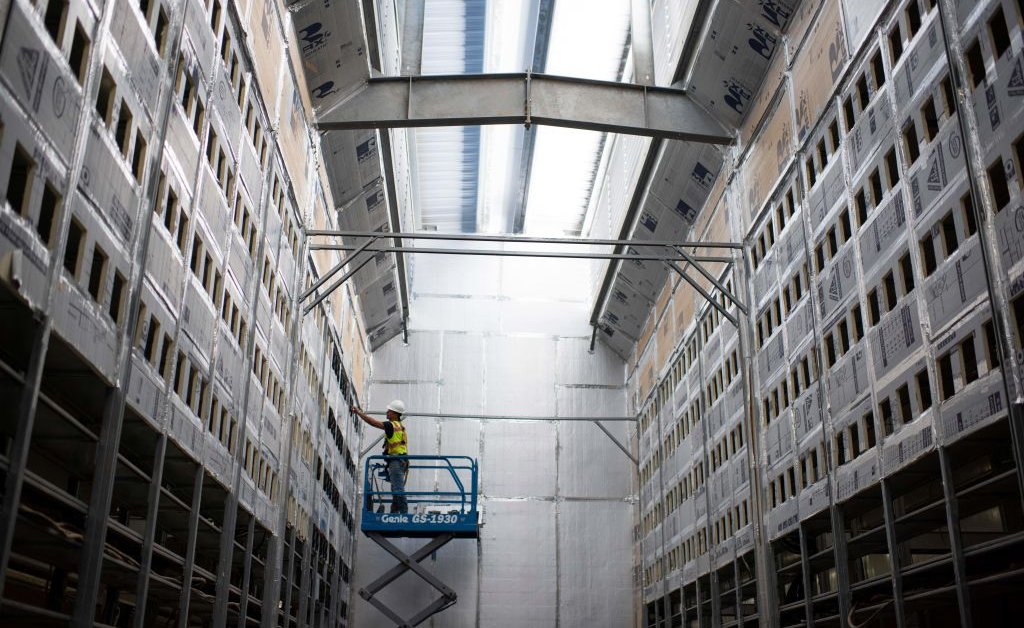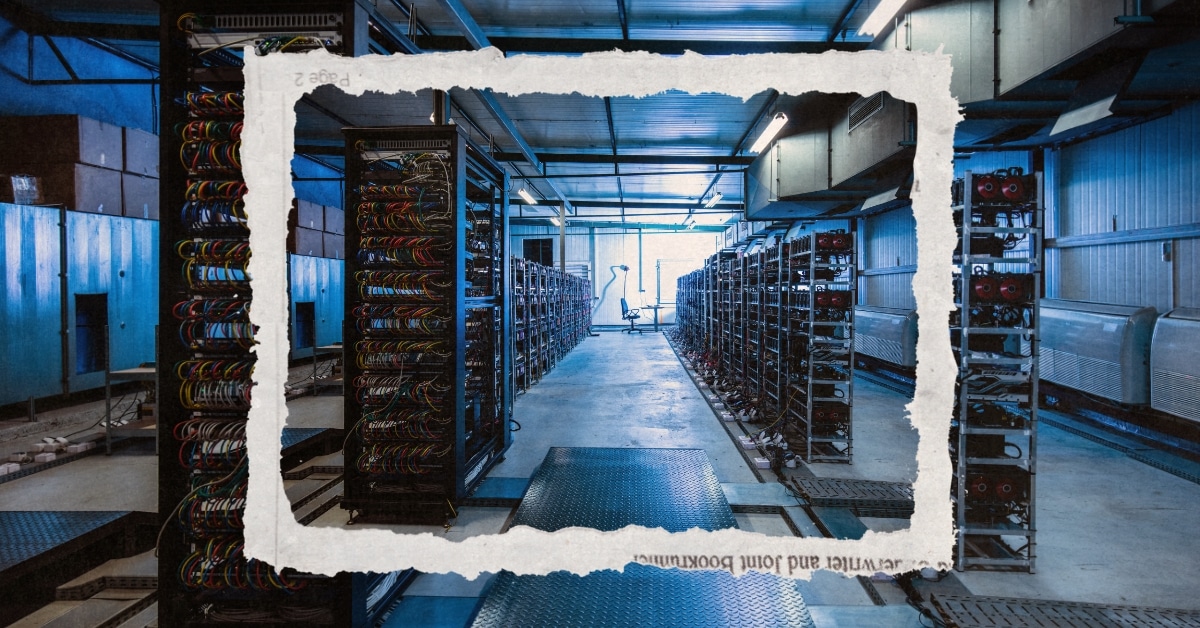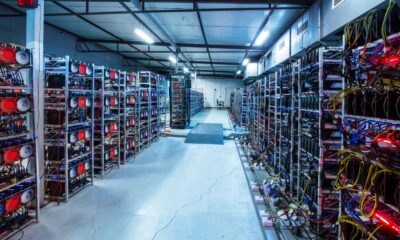News
Why so many Bitcoin mining companies are banking on artificial intelligence

As AI companies work furiously to improve the intelligence and utility of their products, their demand for cheap, abundant energy has skyrocketed. This gold rush has been extremely profitable for an unlikely beneficiary: Bitcoin miners.
In recent months, major Bitcoin mining companies have begun replacing some of their mining equipment with rigs used to operate and train artificial intelligence systems. These companies believe that AI training could provide a safer and more consistent source of revenue than the volatile cryptocurrency sector. And so far, these changes have been warmly welcomed by investors, leading the market capitalization of 14 major Bitcoin mining companies to rise in value by 22%, or $4 billion, since the beginning of June, JP Morgan reported June 24th.
This transition reflects several current trends: the roaring AI hype cycle; diminishing access to power and a tenuous bitcoin mining landscape following the bitcoin halving.
To know more: What’s the problem with Bitcoin halving?
The boom in artificial intelligence has led to a huge demand for energy
Generative AI models like ChatGPT thrive on the raw computational power of data centers, which process massive data sets to find patterns and improve responses. But computing power is expensive and hasn’t been a worthwhile investment for many data center operators for years. When IREN, a data center and bitcoin mining company, looked into using its space for machine learning four years ago, “there wasn’t enough volume from a commercial perspective for it to make sense,” says Kent Draper, IREN’s chief commercial officer.
But the gargantuan success of ChatGPT that began in late 2022 has changed computing, and other AI companies have rushed to train and run their own models in hopes of surpassing OpenAI’s flagship model. This requires an incredible amount of energy: a ChatGPT query, for example, uses 10 times more energy compared to a standard Google query.
That leaves AI companies scrambling for direct access to cheap energy sources, large plots of land to house warehouses filled with thousands of computers, and resources like water or giant fans to cool their machines. Their voracious activity means it’s becoming increasingly competitive to find sites that meet those criteria, especially in North America. Some jurisdictions have implemented long waiting lists for large data centers to connect to the grid. And once companies get initial approval, building a data center from scratch can take years, cost millions of dollars, and require a lengthy slog through regulation and bureaucracy.
To know more: How AI is fueling the data center boom and energy demand
“If you go back five or 10 years, 80% of data center loads were in six or seven primary markets,” says Nazar Khan, COO and CTO of bitcoin mining company Terawulf. “Those markets are full and a couple of them have already issued moratoriums on building additional data centers. So those data center loads are now looking for new homes.”
Bitcoin miners face headwinds
Some of these homes, it turns out, are inside existing bitcoin miners’ facilities. Bitcoin miners maintain and safeguard the bitcoin network through a complex computational process, and they earn bitcoins for doing so. In the early years of bitcoin, miners found that increasing the size of their computers greatly increased their profits, so they built massive server farms that drew on cheap energy sources and ran day and night.
Large-scale bitcoin mining has always been an immensely profitable business. But it is also subject to the whims of the volatile cryptocurrency market. After the cryptocurrency crash of 2022, precipitated by the risky ventures of entrepreneurs like Sam Bankman-Fritto AND Do Kwon– many miners have gone bankrupt or closed down entirely.
Mining companies that survived the crash reaped profits in 2023 and early 2024. But in April, a new challenge emerged: a technical upgrade to Bitcoin called halvingwhich halved the miners’ rewards. Bitcoin miners hoped that the halving would lead to a dramatic increase in the price of Bitcoin, as has happened in previous cryptocurrency cycles, to offset this decrease in rewards. But Bitcoin’s price has remained more or less unchanged since April, squeezing profits and forcing some miners to look for ways to diversify their business models. AI training is at the top of the list.
“You’ve seen a number of cryptocurrency miners who were struggling and actually completely pivoted, and that may have been out of necessity,” Draper says.
The partnership between AI and the bitcoin mining industry is logical, given the needs of both parties. AI companies need the space, access to cheap energy, and infrastructure that bitcoin miners already have. And bitcoin miners want the stability of AI computation revenue and the huge potential profits that come with the current AI hype cycle.
Some bitcoin mining companies are renting their space to AI clients. In June, Core Scientific, which recently emerged from bankruptcy stemming from the 2022 cryptocurrency crash,announced would house more than 200 megawatts of GPUs (graphics processing units, which power the training and operation of AI) for AI startup CoreWeave. Adam Sullivan, CEO of Core Scientific, told TIME in April that AI companies were aggressively bidding for use of Bitcoin mining facilities: “They’ve started buying up mining sites at prices that are higher than Bitcoin miners are willing to pay,” he said. He added that the number of inquiries from AI companies has been “extraordinarily high on our end, and we’re looking at our best go-to-market here.”
Other bitcoin mining companies are running GPUs on their own. On June 24, bitcoin miner Hut 8 received an investment of 150 million dollars by Coatue Management to build an AI infrastructure. And at some IREN facilities, AI GPUs and ASICs (application-specific integrated circuits that power bitcoin mining) share the same walls. “We see them as complementary to each other—they’re quite different business profiles,” Draper says. “Bitcoin is instant revenue but a little more volatile. AI is customer dependent, but once you have customers, it’s contracted and more stable.”
This increase in demand has repercussions on the climate
With bitcoin miners operating in both industries, a huge amount of energy is used. Data centers use 10 to 50 times the energy of a typical commercial office building, says the U.S. Department of Energy He says. A recent Goldman Sachs report predicts that data centers will use 8% of total U.S. energy by 2030, up from 3% in 2022. This level of electricity growth “hasn’t been seen in a generation,” the report says. Light.
Some bitcoin companies, such as Terawulf, say they are focused on using green energy. But many new data centers in general are powered by fossil fuels. “Some of the smaller renewables don’t meet the demand for consistent, high-quality power that some of the high-speed computing professionals need,” Khan says. “You see utilities proposing to add more large-scale gas-fired power plants, which we haven’t seen in several years. It’s going to take a portfolio of facilities: gas, nuclear, renewables to meet that need.”
All this activity concerns climate activists. “Bitcoin miners are diversifying into traditional data centers and AI, and they’re obviously using different machines, but they’re still using massive amounts of energy,” says Mandy DeRoche, deputy general counsel for Earthjustice’s clean energy program. “This massive increase in energy demand has implications for the grid, the cost of electricity, and the climate.”
Andrew R. Chow’s book on cryptography, Cryptomania, will be published in August and is available for pre-order.
News
US Cryptocurrency Rules Delayed by ‘Never-Ending’ Lawsuits

Ripple CEO says cryptocurrency industry still seeking regulatory clarity from US
Speaking to Bloomberg News on Wednesday (July 17), Author: Brad Garlinghouse he said America is behind behind other countries which have already adopted cryptocurrency regulations.
“What we’re seeing, where it’s the UK, Japan, Singapore… even the European Union, more than two dozen countries have come together to provide a framework for cryptocurrency regulation,” Garlinghouse said.
“It’s frustrating that we as a country can’t get that regulatory framework in place. And instead, we have this never-ending lawsuit coming from the SEC that doesn’t really address the problem.”
Ripple has been the target of some of these legal disputes. Securities and Exchange Commission (SEC) sued the company in 2020, accusing it of conducting a $1.3 billion operation offering of unregistered securities tied to its XRP token.
However, last year a judge ruled that only Ripple’s institutional sales of XRP, not retail sales, violated the law, a decision widely seen as a victory for the cryptocurrency industry.
As PYMNTS noted at the time, that ruling has “far-reaching repercussions impact across the digital asset ecosystem, which has long maintained that its tokens do not represent securities contracts.”
However, Garlinghouse told Bloomberg on Wednesday that the company cannot wage multimillion-dollar legal battles over each token.
He spoke to the news agency from the Republican National Convention in Milwaukee, where the party is backing the candidacies of former President Donald Trump and Ohio Sen. J.D. Vance, both of whom are considered pro-cryptocurrency.
But Garlinghouse argued that cryptocurrencies “should not be a partisan issue,” and noted that he had recently attended a conference in Washington that included Democrats, including White House officials.
“I think they were there, listening to the industry… it was refreshing to start having that conversation,” she said.
President Joe Biden earlier this year he vetoed a measure which would have ended the SEC’s special rules for crypto-asset custodians. This legislation was supported by both the digital asset industry and the banking industry.
Ripple early this year donated $25 million to the cryptocurrency industry’s super PAC Fair Smoothiewith Garlinghouse stating at the time that such donations would continue every year, as long as the industry had its detractors.
Second Open SecretsWhich monitor spending For campaigns, the PAC has spent $13.4 million this year, much of it to help defeat Rep. Katie Porter’s (D-Calif.) U.S. Senate campaign.
News
The Future of Cybersecurity in the Cryptocurrency Industry

The cryptocurrency space has had a tumultuous journey, with its fair share of ups and downs. As we look to the future, one area that remains a constant focus is cybersecurity. The digital nature of cryptocurrencies makes them inherently vulnerable to cyber threats, and as the industry evolves, so does the landscape of potential risks.
In 2022, the cryptocurrency market faced significant challenges, with over $2 trillion in market value lost. This event served as a wake-up call for the industry, highlighting the need for robust cybersecurity measures. The future of cryptocurrency security is expected to see a shift towards more regulated and established institutions taking the reins of crypto technology and blockchain infrastructure.
The decentralized nature of cryptocurrencies offers numerous benefits, such as transparency and financial inclusion. However, it also introduces unique security challenges. The risk landscape is filled with threats such as hacking, phishing, ransomware attacks, malware, and social engineering. These threats not only lead to financial losses, but also damage the reputation and trust within the cryptocurrency ecosystem.
Mini-MBA Tekedia edition 15 ((September 9 – December 7, 2024) started recordings; Register today for discounts reserved for early bird customers.
Tekedia AI in Business Masterclass Opens registrations Here.
Join the Tekedia Capital Syndicate and IInvest in Africa’s best startups Here.
The decentralized nature of cryptocurrencies offers many benefits, but it also presents unique security challenges. Cyber risks such as hacking, phishing, and ransomware pose threats to the integrity of digital assets. The infrastructure that supports cryptocurrencies is not immune to vulnerabilities, including smart contract flaws and exchange hacks.
To address these vulnerabilities, the infrastructure that supports cryptocurrencies must be strengthened. Smart contract vulnerabilities, exchange hacks, wallet breaches, and flaws in the underlying blockchain technology are significant concerns that must be addressed to ensure the security and integrity of digital assets.
As cybercriminal tactics and techniques become more sophisticated, the cryptocurrency industry must stay ahead of the curve. The future will likely see more targeted attacks, exploiting weaknesses in infrastructure, networks, and human factors. This requires a proactive and multifaceted approach to cybersecurity.
To mitigate these risks, several measures must be adopted:
Strengthening security measures: Developers, exchanges, and wallet providers must improve security protocols, use strong encryption, implement multi-factor authentication, and conduct regular security audits.
Education and awareness: Users should be educated on best practices for protecting their digital assets, including using strong passwords, recognizing phishing attempts, and using hardware wallets for secure storage.
Looking ahead, the cryptocurrency industry is expected to see an increased focus on robust security measures. Blockchain projects and exchanges are likely to invest in advanced encryption techniques and decentralized storage solutions to protect user assets. The future impact of cyber risk on cryptocurrencies will depend on the collective efforts of stakeholders to address vulnerabilities and strengthen security measures.
Collective efforts by stakeholders in the cryptocurrency space are crucial to address vulnerabilities and strengthen security measures. While challenges persist, advances in cybersecurity technologies and practices offer hope for a more secure and resilient cryptocurrency ecosystem.
The future of cybersecurity in the cryptocurrency industry depends on finding a balance between innovation and regulation. It requires a collaborative effort from all parties involved, from developers to end users, to create a secure environment that fosters trust and growth in the industry. As we move forward, it is critical that lessons learned from past events guide the development of stronger security measures, ensuring the longevity and stability of cryptocurrencies as a vital part of the modern economic toolkit.
Like this:
Like Loading…
News
Bullish XRP and RLBK price predictions rise, outpacing the broader cryptocurrency market, prompting Shiba Inu holders to switch!

Bitcoin’s one-week surge from $60,000 has pushed other cryptocurrencies into an uptrend. However, for many altcoins, this trend has been temporary. Altcoins such as XRP and Shiba Inu (SHIB) have experienced price drops. However, Rollblock, a new altcoin on the Ethereum blockchain, has thrived during this period, attracting thousands of investors looking for long-term growth.
XRP’s Nearly 30% Growth Over Last Week Drops as Selling Pressure Increases
XRP is seeing further price decline as Ripple investors withdraw their profits from the token. The surge in XRP’s price to $0.64 in the past week has provided investors with a perfect opportunity to increase their returns in the short term. With the ongoing sell-off in XRP, XRP has jumped over 8% in the past day and is now trading at $0.59. However, analysts tracking XRP indicators predict that XRP could still extend its gains by over 30% in the coming weeks.
Shiba Inu (SHIB) marks its third consecutive day of losses
Shiba Inu (SHIB) is in a period of adjustment after a week of strong gains. In the last 24 hours, SHIB has seen a jump of over 7%, reflecting a natural market fluctuation. Analysts are observing a death cross on the Shiba Inu chart, which historically signals the potential for future opportunities as the market stabilizes. As investors explore new possibilities, some are diversifying into promising altcoins like Rollblock (RBLK) to strategically rebalance their portfolios and capitalize on the emerging trend.
Rollblock (RBLK) Up Another 7% as New Investors Join Pre-Sale
Rollblock (RBLK) has taken the cryptocurrency market by storm, having attracted investors from more popular altcoins like Shiba Inu (SHIB) and XRP. Rollblock’s growth is attributed to its utility in the $450 billion global gaming industry.
Rollblock aims to use blockchain technology to bridge the gap between centralized and decentralized gambling. With blockchain technology, Rollblock secures every transaction in its online casino, providing transparency and convenience to millions of players who are uncomfortable placing bets on other iGaming platforms.
This innovative use of blockchain technology in the industry has grown Rollblock to over 4,000 new users in less than two months. With plans to add sports betting, this number is expected to grow exponentially in Q3.
Rollblock uses a revenue sharing model that splits up to 30% of its casino’s weekly profits with token holders. This happens after Rollblock buys back $RBLK from the open market and uses half of it for rewards. The other half is burned to increase the price of $RBLK.
Rollblock price has seen four increases in the past month with $RBLK tokens now selling for $0.017. Analysts predict that at the current growth rate, Rollblock could increase by over 800% before the presale ends. For investors looking for a long-term token with growth potential, phase four is the best time to buy Rollblock before its price skyrockets!
Discover the exciting Rollblock (RBLK) pre-sale opportunities now!
Website:https://Rollblockpresale.io/
Social: https://linktr.ee/Rollblockcasino
No spam, no lies, just insights. You can unsubscribe at any time.
News
Texas Crypto Miners Turn to AI as Crypto Declines

As cryptocurrency mining becomes less profitable, Texas cryptocurrency mining companies are switching to supporting artificial intelligence companies.
Bitcoin miners, with their sprawling data centers and access to significant energy resources, are ideally suited for computationally intensive AI operations, and as cryptocurrency mining becomes less profitable, companies see this shift as a logical answer to their problems.
On Thursday, Houston-based Lancium and Denver-based Crusoe Energy Systems announced a multibillion-dollar deal to build a 200-megawatt data center near the West Texas city of Abilene to support advanced artificial intelligence applications such as medical research and aircraft design, CNBC reported. The plant represents the first phase of a larger 1.2 gigawatt project.
Lancium and Crusoe’s move into AI mirrors a broader trend among bitcoin miners. The combined market capitalization of the top U.S.-listed bitcoin miners hit a record $22.8 billion in June. Companies like Bit Digital and Hut 8 are diversifying into AI, with Bit Digital securing a $92 million annual revenue deal to supply Nvidia GPUs and Hut 8 raising $150 million to expand its AI data center.
But the growing popularity of these operations also presents challenges, particularly for the Texas power grid. Last month, the Electric Reliability Council of Texas announced that the state is expected to nearly double its energy production by 2030 to meet the high energy demands of data centers and cryptocurrency operations.
Lieutenant Governor Dan Patrick expressed concern about the projections.
“Cryptocurrency miners and data centers will account for more than 50% of the additional growth. We need to take a close look at these two sectors,” He wrote on Twitter/X. “They produce very few jobs compared to the incredible demands they place on our network. Cryptocurrency miners could actually make more money selling electricity to the network than they do from their cryptocurrency mining operations.”
Analysts predict significant growth in data center power capacity, which is expected to account for up to 9% of U.S. electricity consumption by 2030.
The operations also pose challenges for nearby cities. Earlier this month, TIME reported that a crypto-mining facility was seriously compromising the health of residents in the city of Granbury. TIME reported more than 40 people with serious health problems, including cardiovascular disease, high blood pressure and hearing loss. At least 10 of the residents needed to go to the emergency room or an urgent care facility.
The disturbances were caused by the extreme noise generated by the crypto-mining facility’s fans, which are used to keep the machines cool. While the proposed data center in Abilene would use liquid cooling systems, it’s still unclear whether the facility’s operations would pose a health risk to local residents.
-

 Nfts1 year ago
Nfts1 year agoShardLab Launches ZK-Based Tool for Digital Identity and NFT Vouchers
-

 News1 year ago
News1 year agoWallet recovery firms are abuzz as stranded cryptocurrency investors panic in the bitcoin boom
-

 Bitcoin1 year ago
Bitcoin1 year agoBitcoin, Ethereum, Solana and Cryptocurrency Markets Look Ready to ‘Send’ as Stars Align, According to Investor Chris Burniske
-

 Altcoins12 months ago
Altcoins12 months agoThree Altcoins Poised for Significant Growth in 2024: ETFS, OP, BLAST
-

 Altcoins12 months ago
Altcoins12 months agoAccumulate these altcoins now for maximum gains
-

 Nfts1 year ago
Nfts1 year agoOG Crypto Artist Trevor Jones Unveils Groundbreaking Collection of Ordinals | NFT CULTURE | NFT News | Web3 Culture
-

 Bitcoin1 year ago
Bitcoin1 year agoBillionaires are selling Nvidia stock and buying an index fund that could rise as much as 5,655%, according to some Wall Street analysts
-

 Videos9 months ago
Videos9 months agoKamala just won the boner! [Bad For Crypto]
-

 Videos1 year ago
Videos1 year agoLIVE FOMC 🚨 Could be CATASTROPHIC for Altcoins!
-

 News1 year ago
News1 year agoA Guide for Newcomers & Beginners – Forbes Advisor
-

 Videos1 year ago
Videos1 year agoAttention: a historically significant BITCOIN signal has just appeared!
-

 Videos1 year ago
Videos1 year agoSTOCK MARKET FUD! ⚠️ [Why This Is GREAT For Bitcoin Traders!]



















